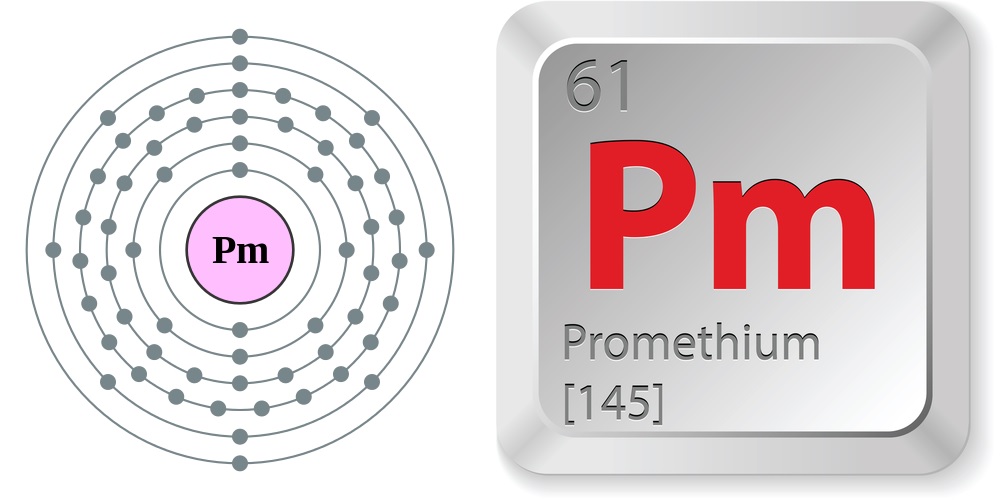Facts About Promethium

Named for the Greek Titan who stole fire from Zeus and gave it to humanity, glow-in-the-dark promethium is a highly radioactive, rare earth element. It is not found anywhere on Earth and is found in the byproducts of uranium fission reactions. Due to its rarity, its primary purpose is for research; it has possibilities for use in a variety of medical devices, batteries, and in luminescent paint.
Just the facts
- Atomic number (number of protons in the nucleus): 61
- Atomic symbol (on the periodic table of elements): Pm
- Atomic weight (average mass of the atom): 145
- Density: 4.17 ounces per cubic inch (7.22 grams per cubic cm)
- Phase at room temperature: solid
- Melting point: 2,088 degrees Fahrenheit (1,142 degrees Celsius)
- Boiling point: 5,972 F (3,300 C)
- Number of natural isotopes (atoms of the same element with a different number of neutrons): at least 38 radioactive isotopes
- Most common isotopes: Pm-145 (negligible percent of natural abundance), Pm-147 (negligible percent of natural abundance)
History
When Dmitri Mendeleev organized what is now known as the periodic table in the late 1860s, he left gaps for unknown elements based on a variety of properties. Bohuslav Brauner in 1902 expanded on Mendeleev's table and created places for newly discovered elements that didn't fit on the original table and created more blank spaces for the unknowns, as Mendeleev did, according to Peter van der Krogt, a Dutch historian. One such space was element 61, which lies between neodymium and samarium.
Henry Moseley, a British scientist, confirmed the X-ray radio signature of the unknown element in 1914, and several claims of the physical discovery of promethium followed:
- Luigi Rolla and Lorenzo Fernandes, Italian chemists, published their discovery in 1924 via a sealed envelope sent to the Royal Accademia dei Lincei in Rome. The researchers proposed the name florentium (Fr) after their home city of Florence, Italy.
- B. Smith Hopkins, Yen Yntema, and a student named Harris, researchers at the University of Illinois, claimed discovery in 1926 and suggested the name illinium (Il) after the state Illinois.
- Laurence L. Quill and colleagues published their results in 1938 of an element named cyclonium, after the cyclotron at Ohio State that the researchers used to bombard various projectiles at neodymium and samarium, producing several radioactive isotopes.
- Chien Shiung Wu, Emilio G. Segrè, and Hans Albrecht Bethe, researchers at University of California Berkeley, published their discovery of element 61 by bombarding neodymium and praseodymium with neutrons, but had difficulties separating out the new rare-earth element.
Although it is possible that promethium was actually produced in several of these cases, other researchers could not confirm any of them.
The first successful identification and separation of element 61 was in 1945 by Charles D. Coryell, Jacob A. Marinsky, Lawrence E. Glendenin and Harold G. Richter, researchers for the Manhattan Project in Oak Ridge, Tennessee, during their studies in creating fuel for an atomic bomb, according to van der Krogt. They were able to identify isotope promethium-147 in the byproducts of uranium fission. Their results were confirmed by utilizing a mass spectrometer and published in 1947, delayed due to their involvement in World War II research efforts. The name promethium was suggested by Grace Mary Coryell, Coryell's wife, and the name was adopted by the International Union of Chemistry in 1949.
Who knew?
- In Greek mythology, Prometheus was a champion of humankind. After he stole fire from Zeus and gave it to mortals, Zeus punished him by having him bound to a rock while an eagle ate his liver every day only to have it grow back to be eaten again, according to van der Krogt.
- The element was named after Prometheus for the courage and pain needed to synthesize it.
- Bohuslav Brauner, a Czech chemist, predicted the existence of promethium in 1902, according to the Jefferson Laboratory.
- According to Chemicool, promethium was the last of the rare earth lanthanide elements to be discovered.
- Promethium is very radioactive and emits beta radiation, according to Lenntech.
- According to Chemicool, metallic promethium is silvery white, and the salts glow in the dark with a pale blue or green light.
- The longest-lived isotope of promethium is promethium-145 with a half-life of 17.7 years, according to the Jefferson Laboratory.
- Promethium is the only rare earth, radioactive metal on the periodic table, according to Chemicool.
- There appears to be no promethium in Earth's crust, according to the Los Alamos National Laboratory. The element has been discovered, however, in the spectrum of star HR465 (GY Andromedae), which lies 520 light-years away in the Andromeda constellation. Margo F. Aller and Charles R. Cowley, astronomers at the University of Michigan, detected promethium in the star in 1970, according to the 1970 paper published in the Astrophysical Journal.
- Promethium may have once existed in Earth's crust close to its formation, but it would have all decayed within 10,000 years, according to Lenntech.
- Promethium is recovered from the leftovers of uranium fission. It can be produced by bombarding neodymium-146 with neutrons to become neodymium-147, which beta decays over its 11-day half-life into promethium-147, according to the Jefferson Laboratory.
- The primary use for promethium is for research. According to Los Alamos National Laboratory, other uses include it being absorbed by a phosphor to produce light, as a beta source for thickness gauges, in nuclear-powered batteries (which last about five years), and possibilities as a portable X-ray source and heat source for space probes and satellites.
Current research
The majority of promethium is used for research purposes, and it doesn't have many other uses due to its high radioactivity and very limited supply. One such commercial use for promethium is for a power source for medical devices.
A patent filed in 2014 by Peter Cabauy, CEO of City Labs, discusses a new design for a betavoltaic power source where the beta particles come from the decay of promethium-147, tritium, or nickel-63. The technology is based on a design from the early 1970's that used promethium-147 to power a cardiac pacemaker that was successfully implanted in over a hundred patients.
Get the world’s most fascinating discoveries delivered straight to your inbox.
Some of the benefits described by Cabauy in the patent are that promethium-147 is more readily available and less expensive then other options for short-lived medical implant sensors and it can be used in its metallic form. The power source design is meant for small form medical devices and can also be used in any applications where the small size battery is desirable.
Additional resources

Rachel Ross is a science writer and editor focusing on astronomy, Earth science, physical science and math. She holds a Bachelor of Arts in Philosophy from the University of California Davis and a Master's degree in astronomy from James Cook University. She also has a certificate in science writing from Stanford University. Prior to becoming a science writer, Rachel worked at the Las Cumbres Observatory in California, where she specialized in education and outreach, supplemented with science research and telescope operations. While studying for her undergraduate degree, Rachel also taught an introduction to astronomy lab and worked with a research astronomer.



